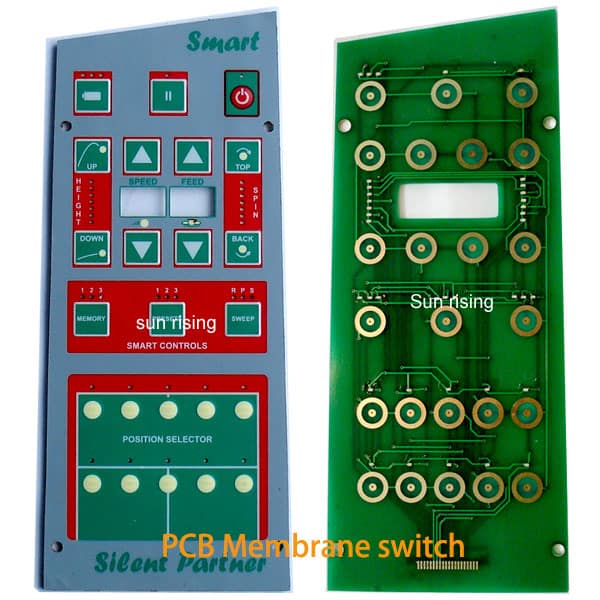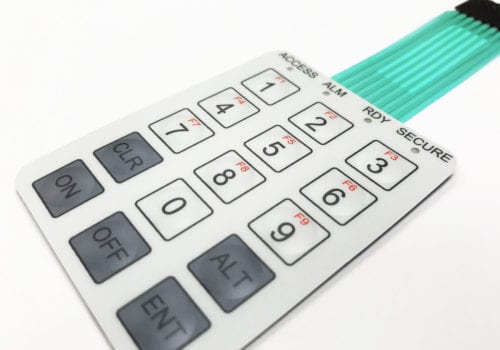The Major Benefits of Using Membrane Switches in Industrial Applications
The Major Benefits of Using Membrane Switches in Industrial Applications
Blog Article
Membrane Switch Over Innovation: The Key to Trustworthy and Economical Interfaces
Membrane layer button innovation has actually emerged as a crucial element in the style of user interfaces, providing both integrity and cost-effectiveness throughout a diverse series of applications. Its durable construction makes sure resistance to ecological difficulties, while the versatility in layout allows for customized remedies that meet particular sector requirements. As we discover the complex benefits of membrane buttons, their potential for development questions concerning future applications and developing patterns. What does the following chapter hold for this modern technology in a progressively electronic landscape?
Understanding Membrane Layer Change Technology
Membrane layer button technology is a widely utilized interface option in different digital gadgets, supplying a smooth blend of functionality and design. This technology includes numerous layers of materials, usually being composed of a visuals overlay, spacer layer, and a circuit layer. The graphic overlay displays the user interface components, while the spacer layer divides the circuit layer from the overlay up until an individual triggers a switch.
When pressure is put on the overlay, the circuit layer completes the electrical circuit, sending a signal to the device. This mechanism permits various setups, including responsive comments and backlighting options, improving user interaction. Membrane layer switches are commonly made using long lasting materials such as polyester or polycarbonate, guaranteeing durability and resistance to ecological variables like moisture and dirt.
The flexibility of membrane layer switches over enables their application in diverse sectors, consisting of clinical tools, consumer electronics, and industrial controls. Their portable design permits for integration into space-constrained atmospheres, giving an effective interface without compromising aesthetic appeal. Comprehending the intricacies of membrane switch technology is necessary for producers and developers seeking to create trustworthy and effective human-machine interfaces.
Trick Advantages of Membrane Layer Switches
While various user interface remedies exist, membrane layer changes deal distinctive benefits that make them a favored selection in many applications. Among the primary benefits is their longevity; membrane switches are designed to endure extreme environmental problems, consisting of wetness, dirt, and temperature level changes, making sure lasting efficiency. This resilience dramatically minimizes the need for regular replacements, thus lowering total upkeep prices.

Additionally, membrane layer buttons are light-weight and compact, making them appropriate for applications where space is limited. Their low-profile layout adds to a sleek look without endangering performance.
Cost-effectiveness is additionally a remarkable advantage, as Related Site the production procedure for membrane layer switches over often tends to be less costly compared to standard mechanical switches. This affordability, integrated with their reliability and convenience of setup, positions membrane layer changes as a functional service for a variety of industries looking for efficient and reliable interface.
Applications Throughout Various Industries
Exactly how do membrane layer buttons adapt to the varied demands of various sectors? Membrane switch technology is progressively identified for its versatility, making it suitable for a large array of applications across multiple industries.
In customer electronic devices, membrane layer switches provide a small option for remotes and home devices, find more boosting customer experience through intuitive design. Additionally, the industrial industry leverages membrane layer buttons for machinery control panels, taking advantage of their resistance to severe settings, such as moisture and dust.
Military and aerospace applications also utilize membrane switches for their reliability and ability to hold up against severe problems, making certain functional performance in essential circumstances. The food and beverage industry takes on these buttons for automated systems, where cleanliness and simplicity of operation are critical (membrane switch). Inevitably, membrane buttons are customized to satisfy the unique demands of each sector, showing their important duty in modern-day technology interfaces
Layout and Modification Choices

In the realm of membrane switch technology, style and personalization options play a crucial duty in boosting capability and individual communication. These switches can be tailored to satisfy particular functional demands and aesthetic choices, making them flexible components in numerous applications.
One of the primary personalization options is the format of the button itself, which can be developed to suit special interface and ergonomic factors to consider. By changing the form, size, and plan of switches, suppliers can create instinctive layouts that help with convenience of use. In addition, the consolidation of different colors and visuals overlays enables branding and enhanced presence, making certain that individuals can promptly determine features.
Furthermore, membrane layer buttons can be crafted with various responsive responses mechanisms, such as increased switches or audible clicks, to enhance the individual experience. from this source Various products can likewise be chosen for durability and ecological resistance, attending to aspects such as dampness, temperature changes, and chemical direct exposure.
Inevitably, the extensive style and personalization alternatives readily available in membrane button modern technology encourage services to create tailored remedies that not just meet functional demands however additionally straighten with their branding and functional needs.

Future Trends in Membrane Switches
As membrane switch innovation proceeds to develop, future patterns are progressively concentrated on enhancing individual experience and integrating innovative capabilities. One significant trend is the integration of touch-sensitive and capacitive innovations right into typical membrane switches. This development permits more instinctive interface, offering responsive responses while keeping a sleek layout.
Another arising fad is making use of eco-friendly products, driven by the growing need for sustainable production methods. Makers are looking for to lower their carbon footprint by using recyclable substrates and low-impact inks, straightening with worldwide sustainability goals.
In addition, the increase of the Web of Points (IoT) is triggering the incorporation of clever features into membrane switches. Boosted connectivity options will allow tools to connect with each various other, enabling smooth combination into broader systems.
Furthermore, innovations in printing innovations, such as electronic printing, are enabling for greater layout flexibility and modification. This makes it possible for suppliers to generate intricate layouts and vibrant colors cost-effectively.

Verdict
Finally, membrane layer button innovation stands for a vital innovation in interface layout, providing significant benefits in longevity, customization, and cost-effectiveness. Its prevalent applicability throughout varied markets highlights its value in modern-day innovation. As improvements remain to arise, especially in touch-sensitive interfaces and lasting materials, the potential for membrane switches to improve customer experience and performance remains encouraging. Proceeded expedition of this modern technology will likely generate further improvements and broaden its range in future applications.
Report this page